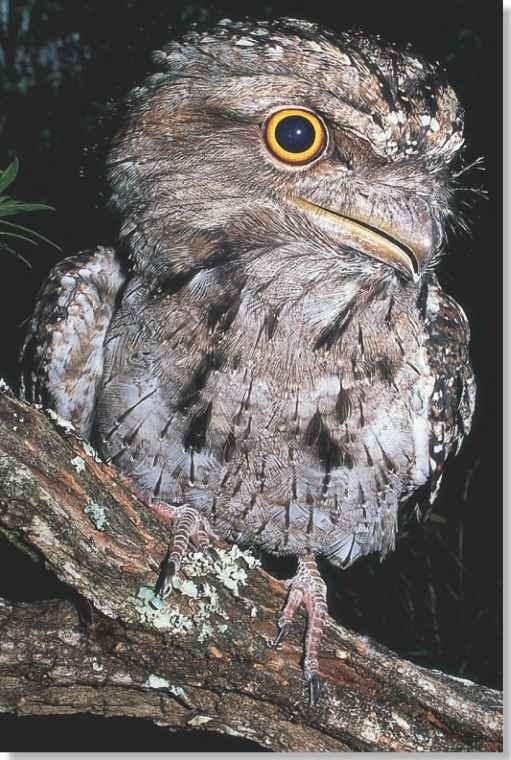ORDER
Caprimulgiformes
FAMILY
Podargidae
GENUS & SPECIES
key features
• A nocturnal hunter ; and daytime rooster;
thrives in a number of different habitats ^throughout its range
• Equipped with excellent camouflage that enables it to hunt or hide undetected by either prey or predator
• Feeds on a variety I of food, ranging from insects and frogs to small mammals and even cultivated citrus fruits
where in the world?
Found throughout the mainland of Australia and Tasmania; also occurs on New Guinea and the Solomon Islands
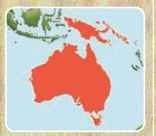
LIFECYCLE
Seemingly oblivious to the march of human settlement across Australia, the tawny frogmouth remains one of the most widely distributed birds on the continent.
HABITAT
The tawny frogmouth is common throughout its range. It is most numerous in dense woodland and forest, where its mottled plumage blends with the backdrop of lichen-covered branches.
In eastern Australia, the vast eucalyptus forests west of the Great Dividing Range provide excellent cover. In northern parts of Australia and in New Guinea, the tawny frogmouth makes its home
in dense tropical rainforests. In urban areas, it has become a regular inhabitant of gardens and parkland.
Shower time A tawny frogmouth takes a welcome rain bath.
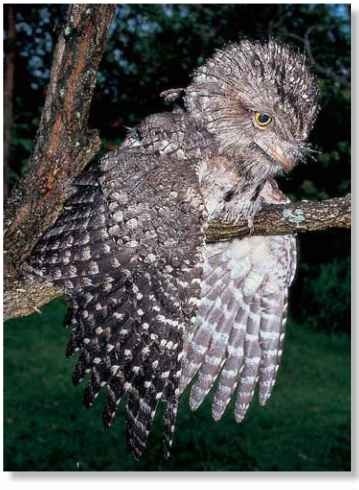
BEHAVIOR
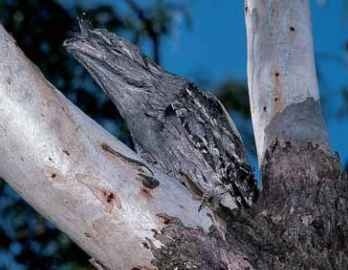
A Wooden performance The frogmouth freezes statue-still when alarmed.
A night hunter, the frogmouth roosts during the day on a branch or hides within a tree hole to avoid the midday heat.
Snakes and predatory birds are the frogmouth s major enemies, and the bird’s most common defense is to adopt its spectacularly effective alarm posture. Stretching out its head, it flattens its wings against its body, narrows its eyes to a slit and remains motionless. In an instant the bird melts from view, seeming to fuse with the tree itself. Its patterned plumage, resembling intricately marbled tree bark, completes the effect. The frogmouth holds the posture until the danger has passed.
The species owes its name to naturalists who witnessed it using its mouth like a frog to catch flying insects in midair.
The frozen posture of the tawny frogmouth is so effective that it waits until an intruder is only about 3′ away before flying off to safety.
CONSERVATION
The tawny frogmouth is one species of Australian wildlife that hasn’t suffered at the hands of human expansion. Its adaptability has ensured that numbers remain stable, but the use of insecticides in gardens, parklands and golf courses may put pressure on its urban populations.
FOOD & HUNTING
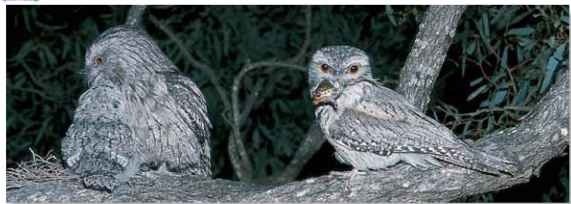
A Floor selection
In its woodland habitat, the frogmouth dines on an abundance of small mammals and amphibians.
Beetles, centipedes, frogs and mice are frogmouth favorites. It hunts mainly at night, swooping to catch prey on the ground or grabbing an insect in flight. The frogmouth returns to its perch to eat its prize.
The frogmouth is also adept at finding food in human settlements. It is
not unusual to see the bird perched by the roadside, waiting to scavenge a roadkill. Likewise, it is a common sight near orchards and farms, where it feeds freely on citrus fruit.
NIGHT STRIKE
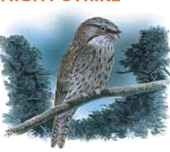
Watching…
An open forest setting is an ideal spot for the frogmouth to perch, stationary, on a branch.
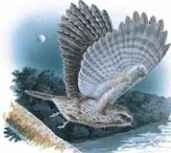
Lift off…
Spotting a moth, the frogmouth leaves its perch and silently flies down toward its victim.
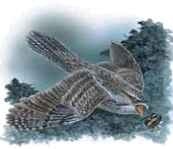
Opening time…
The frogmouth swoops closer to the moth, its wide, shallow mouth agape. It rarely misses its target.
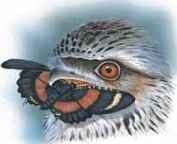
Mouthful
With the moth safely in its bill, the frogmouth flies back to its perch to devour it.
BREEDING

Bodyguard Vulnerable nestlings are sheltered by both parents.
The tawny frogmouth lives in pairs that nest and roost together all year-round. Mating can occur in any month, although there are localized peaks. Partners share the duties of rearing the young, but the male constructs the nest.This is a loose platform of sticks and leaves, usually sited on a forked branch or even in the discarded nest of another bird species. The bird adds spider’s webs, lichen and its own feathers to disguise the nest.
The female lays two eggs, and takes on most of the 30-day incubation. Both parents feed the chicks, mainly small insects. After a month or so the fledged young are able to leave the nest. Their parents may mate again soon afterward.
PROFILE
Tawny Frogmouth
The tawny frogmouth is odd-looking, but its short-necked profile and patterned plumage are key elements in its superb disguise.

Tawny frogmouth
CREATURE COMPARISONS
The common potoo (Nyctibus griseus) is found in the West Indies and from western Mexico to Uruguay. Roughly the same size as the frogmouth, the potoo has similar gray, streaked plumage. It, too, is found in wooded environments, relying on its plumage for camouflage. Its smaller bill has a sharper hook but the same protective bristles above it as the frogmouth’s. Both birds catch insects on the wing, but the larger bill of the frogmouth enables it to take larger prey. ” Like the frogmouth, the potoo roosts during the day, perched motionless on a branch; unlike the frogmouth, it never lands on the ground.The potoo owes its name to its melancholy call: a descending poh-o oh oh oh oh.
vital |
|
| statistics | |
| Weight | 2.5-4 oz. |
| Length | 14-20″ |
| Wingspan | 18-24″ |
| Sexual Maturity | 1 year |
| Breeding Season | Varies across range |
| Number of Eggs | Usually 2 |
| Incubation period |
30 days |
| Fledging Period | 30 days |
| Breeding Interval | As short as 2 months, though usually annual |
| Typical Diet | Large insects, small mammals, fruit |
| Lifespan | Unknowns-’ |
Related species
• The tawny frogmouth is 1 of 3 species in genus Podargus. The Papuan frogmouth, P. papuensis, and the marbled frogmouth, P. ocellatus, are the others. Their i order, Caprimulgiformes, includes the European nightjar, Caprimulgus europaeus (below).

